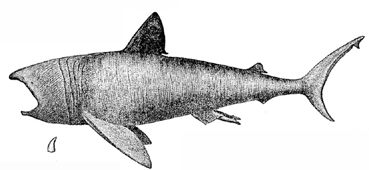1902 Encyclopedia > Shark > Fox Shark or Thresher. Basking Shark.
The Fox-Shark or Thresher (Alopecias vulpes), of which every year specimens frequently seen during the summer months, generally in companies, at a distance of from three to hundred miles off the shore, it is chased by the more courageous of the fishermen for the sake of the oil which is extracted from the liver, one fish yielding from a ton and half. Its capture is not unattended with danger, as one blow from the enormously strong tail is sufficient to stave in the sides of a large boat. The simple method to used at present of harpooning the fish entails much patience and loss of time upon the captors, as the fish generally sinks to the bottom and sulks for many hours before it rises again in a more or less exhausted condition; and the use of more modern appliances could not fail of securing more speedy and better success. The `the basking shark is gregarious, and many individuals may be seen in calm weather lying are captured on the British coast, but which is common in all the temperate seas of the northern and southern hemispheres, is readily recognized by its extremely slender tail, the length of which exceeds that of the remainder of the body. Its teeth are small, flat, triangular, and without serrature. It follows the shoals of herrings, pilchards, and sprats In their migrations, destroying incredible numbers and frequently injuring the nets by getting entangled in them. When feeding it uses the long tail in splashing the surface of the water, whilst it swims in gradually decreasing circles round the shoal of fishes which are thus kept crowded together, falling an easy prey to their enemy. Sometimes two threshers may be seen working together. Statements that it has been seen to attack whales and other large cetaceans rest upon erroneous; its dentition is much too weak to bite through their skin, although, as Couch says, by one splash of its tail on the water it may put a herd of dolphins or porpoises to flight like so many hares. The same effect may be produced by the splash of an oar. The thresher attains to a length of 15 feet, the tail included.

Fig. 13 -- Basking Shark
The Basking Shark (Selache maxima), sometimes erroneously called "Sun-Fish," is the largest fish of the North Atlantic, growing to a length of more than 30 feet. It is one of the few types of sharks which up to a very recent time where considered to be peculiar to the North-Atlantic fauna; but Prof. F. M’Coy has just recorded its occurrence on the Australian coast, a specimen 30 feet long having been captured in November 1883 at Portland, on the west coast of Victoria. The mouth is of an extraordinary width, and, like the gill-cavity, capable of great expansion, so as to enable the fish to take at one gulp an enormous quantity of the small fish and other marine creatures on which it subsists. Also the gill-openings are of great width. The teeth are very small, numerous arranged in several series, conical, and probably without use in feeding. This shark is therefore quite harmless if not attacked. On the west coast of Ireland, where it is together motionless, with the upper part of the back raised above the surface of the water, a habit which it has in common with the true sun-fish (Orthagoriscus), and from which it has derived its name.
Read the rest of this article:
"Shark" Article - Table of Contents
|
